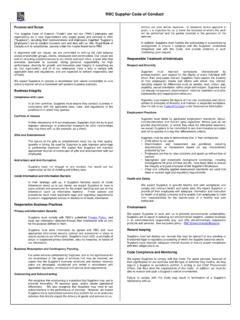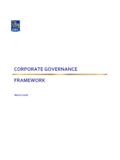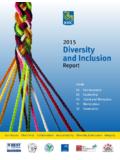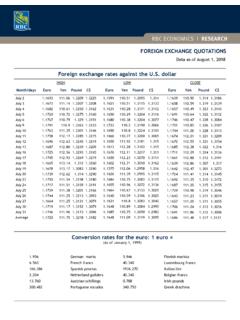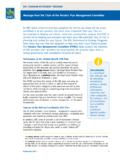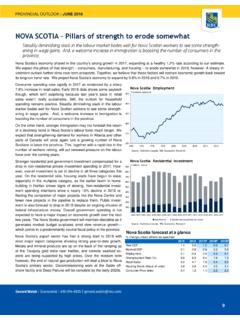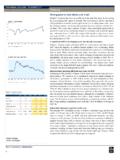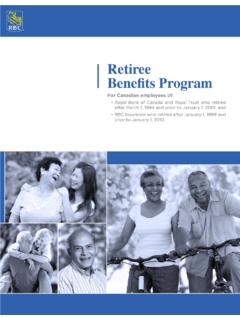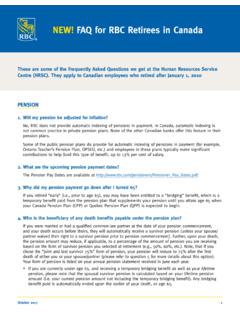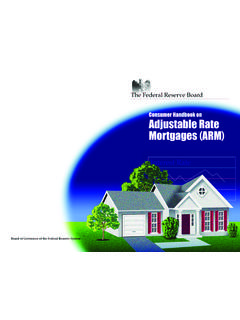Transcription of CANADA’S HOUSING MARKET - RBC
1 canada S HOUSING MARKETO ctober 17, 2017As expected, OSFI tightens rules for non-insured mortgagesStarting on January 1, 2018, residential mortgage borrowers with a down payment of more than 20% will need to qualify at a signifi-cantly higher rate when they do business with a federally-regulated mortgage lender. This was officially announced today by the Of-fice of the Superintendent of Financial Institution (OSFI) as part of final revisions to so-called Guideline B-20 on residential mortgageunderwriting and procedures. The change isn t a surprise, though, because a close version of it was included in a draft circulated byOSFI in July.
2 And superintendent Jeremy Rudin recently expressed the view that such a move was necessary to further safeguard Ca-nadian households and the financial the revised guideline, federally-regulated financial institutions (FRFIs) must set the qualifying rate for non-insured mortgages atthe greater of the contractual mortgage rate plus 2 percentage points or the five-year benchmark rate published by the Bank of Cana-da. This brings the qualifying rules for FRFI non-insured mortgages more closely in line with those for insured mortgages (which weretightened a year ago).
3 The higher qualifying rate clearly represents a very stringent stress test . For example, to be able to buy the same average home inCanada (slightly over $500,000) after the change, a buyer will be required to have a minimum income that is $16,000, or 18%, higherthan is currently needed based on the increase from the current five-year rate ( ) to a rate that s 2 percentage points higher. Thiswill be an impossible rise for many buyers. Indeed, canada s large banks recently estimated that approximately 10% of their mortgageoriginations will be negatively affected by the change.
4 The new rule doesn t require financial institutions to re-qualify borrowers at theend of their term if they renew at the same expect that, following a brief run-up in activity fueled by buyers rushing to lock-in existing qualifying criteria, the change willhave a dampening impact on the HOUSING MARKET shortly after it comes into effect in January. It has the potential initially to rock themarket because non-insured mortgages represent a large share of the mortgage MARKET . Roughly 45% of domestic banks mortgageportfolios and more than 70% of originations are non-insured.
5 Nonetheless, the ultimate impact on the HOUSING MARKET will depend onthe extent to which borrowers will migrate to non-federally regulated mortgage lenders that will not be subject to the new OSFI lenders include provincially regulated credit unions and caisses populaires. Our view is that such migration is likely to be today s announcement poses downside risks to our recently-released HOUSING forecast, we believe that the most likely outcomefor canada s MARKET remains a soft landing. We expect that, at the margin, the higher qualifying rate will drive some buyers out of themarket and reduce the budget of others next year both factors adding downward pressure on prices.
6 Yet the odds of a crash landingare still low. Longer term, OSFI s revised guideline will enhance the resilience of canada s households and financial system in theface of various potential revisions to the B-20 guideline include more stringent requirements for the measurement of loan-to-value (LTV) ratios and moreexplicit restrictions on co-lending arrangements. We expect minimal impact on the HOUSING MARKET from these other HogueSenior Economist | 416-974-6192 | S HOUSING MARKET |OCTOBER 17, 2017 RBC ECONOMICS| RESEARCH2 The material contained in this report is the property of Royal Bank of canada and may not be reproduced in any way, in whole or in part, without express authoriza-tion of the copyright holder in writing.
7 The statements and statistics contained herein have been prepared by RBC Economics Research based on information fromsources considered to be reliable. We make no representation or warranty, express or implied, as to its accuracy or completeness. This publication is for the infor-mation of investors and business persons and does not constitute an offer to sell or a solicitation to buy securities. Registered trademark of Royal Bank of canada . Royal Bank of canada .
